The Impact of Demand Response Programs on Reducing the Emissions and Cost of A Neighborhood Home Microgrid
Abstract
:1. Introduction
- Time-based programs are generally utilized to usage over broad blocks of hours. Time-base programs methodologies include Time of Use (TOU), Real-time Pricing (RTP), Critical Peak Pricing (CPP), Critical Peak Rebates (CPR), etc.
- Incentive-based programs encourage the consumers to alter their energy consumption by proposing the incentives programs offered by the energy provider. The methods include Direct Load Control (DLC), Interruptible/curtail able service (I/C), Emergency Demand Response Program (EDRP), Ancillary Service Markets (A/S), etc.
- It provides a comprehensive and flexible DR strategies based on price, emission, and price-emission. By DRP, DRE, and DRPE, the H-MGs’ owners are able to choose dynamically the most appropriate DR programs based on their appliances situations.
- It proposes a multi-objective EMS based on optimization methods and DR strategy to enhance energy independence, decrease air pollution and costs for subscribers, as well as gaining more productivity of non-dispatchable units.
- It provides a solution to achieve the collective consumers’ payoffs, despite the presence of players with different levels of ownership and goals.
2. Description of General Idea
3. The Structure of Proposed Algorithm
3.1. EMS-DR Unit
- EMS-DRP: At this level of EMS, cost reduction has been considered through the power demand shift. According to Figure 3, each H-MG must first respond to its power demand through embedded non-dispatchable units. If power demand is lower than power generation by non-dispatchable units and the power shortage is higher than the minimum CHP generation, then CHP goes into orbit. Two things happen in this case: (i) due to CHP, the power shortage will be lost and a surplus of power generation will occur; or (ii) the shortage of generation will continue to be less intense. If there is still a shortage of generation, ES will be discharged according to ES capacity and constraints. If there is still a problem with power dissipation in the ES, then according to the DR constraints, power shortages are shifted to other time when the cost of power is cheaper. It should be noted that the EMS only can shift a certain amount of power to future periods, otherwise it would have to generate a power loss through load energy market. In this case, the purchase priority is with other H-MG neighbors, followed by the retailer, due to the fact that H-MGs are able to accrue the profit whilst the lack of purchasing from retailers also reduces the pollution caused by traditional electricity generation systems.With these interpretations, if the CHP enters the circuit and the power generation surplus occurs, the EMS can charge ES according to the constraints of the issue, and respond to the DR whilst selling its excess power in load energy market, which is the priority of purchasing with Other H-MGs and then retailers. For this purpose, H-MGs should position their pre-bid price at a level that is lower than the retailers offer. Flowcharts of the electrical sections are shown in Figure 3a. As depicted in Figure 3b, DR is not considered in the thermal sector. In the thermal sector, in the first place, TSP and CHP have an obligation to respond to the thermal loads. If there is a lack of thermal power, since there is no emission constraint on H-MG #A, then GB enters the circuit and responds to loads.
- EMS-DRE: In this section, EMS has focused its efforts on reducing pollution using DR. Emax is introduced as a pollution indicator. In more detail, let Y be a finite set of random variable regarding the pollution of a large-scale power network (Emission of Electricity Consumption in UK Power System [44]) with finite outcomes . Hence, Emax equals representing the expected value of Y. As shown in Figure 4a, if the need for using CHP arises, it must first be checked that the amount of power shortage is higher than the minimum CHP generation power, and then check whether the CHP inflow circuit exceeds the Emax pollution index. If it passes through Emax, the algorithm allows benefiting the CHP only to the extent that it does not violate Emax. Considering this important constraint, and with the entrance of CHP to the orbits, the reduction of the power shortage or surplus of power generation occurs, with the algorithm continuing to function as in the previous section. In the thermal sector, although DR is not taken into account, considering that the DR applied in H-MG #B tries to reduce pollution, and with making the use of GB, the pollution will increase, therefore GB enters the circuit with limitations. As shown in Figure 4b, GB can only generate thermal power just insofar as it does not exceed the Emax index.
- EMS-DRPE: In this section, the proposed algorithm controls both price and pollution using DR. For this purpose, the “adjustment point” is considered for the price of power to serve as an indicator of demand shifts. At each time interval, the MCP value, with due consideration given to uncertainty, is first examined. If the MCP value is higher compared to the adjustment point, and provided the ES has a discharge capability, it discharges the ES algorithm. Furthermore, if there is still a power shortage, it will transfer part of the load according to the defined constraints in proportion to the generation state of the non-dispatchable units and loads. However, if the MCP value is small, and the power shortage is greater than the minimum CHP generation, the algorithm will measure the pollution condition in proportion to Emax. If the amount of pollution resulting from the entrance of CHP to the circuit is less than Emax, an excess in power generation or reduction of power shortage occurs, in accordance with the situation, as in the previous sections of the algorithm. It should be noted that, if, as a result of the entrance of CHP to circuit, the pollution breaks out of Emax, an algorithm that is less than or equal to Emax will allow CHP to operate. Figure 5 shows the EMS-DRPE electric flow chart section. It should be remarked that the thermal section of H-MG #C is quite similar to the H-MG #B.
3.2. MCP Unit
3.3. Taguchi Orthogonal Array Testing (TOAT) Unit
4. Mathematical Implementation of the Problem
4.1. Objective Functions of the Participants in MO-TE
4.2. Technical and Economical Constraints
5. Results and Discussion
6. Conclusions
Author Contributions
Funding
Acknowledgments
Conflicts of Interest
Nomenclature
| AEL | Aggregated electrical load |
| ATL | Aggregated thermal load |
| CHP | Combine heat and power |
| DE | Differential evolution algorithm |
| DR | Demand respond |
| DR+, DR- | Amount of responsive load demand that goes/comes to/from other time period |
| DP | Dynamic Pricing |
| DW | Dish washer |
| DT | Duration Time |
| DRP | Demand response based on price |
| DRE | Demand response based on emission |
| DRPE | Demand response based on price and emission |
| ES | Energy storage |
| ESP | Electrical solar panel |
| EMS | Energy management system |
| EMS-DR | Energy management system based on Demand respond |
| EMS-DRP | The EMS Algorithm Including DR based on Price |
| EMS-DRPE | The EMS Algorithm Including DR based on Price and Emission |
| EN | Energy |
| EV | Electric vehicle |
| GB | Gas boiler |
| HHW | Heat and hot water |
| H-MG | Home Microgrid |
| MCP | Market clearing price |
| PSO | Particle swarm optimization |
| REF | Refrigerator |
| RET | Retailer |
| SBP | System buy price |
| SSP | System sell price |
| SOC | State of charge |
| TD | Thermal dump |
| TES | Thermal energy storage |
| TSP | Thermal solar panel |
| TOAT | Taguchi Orthogonal Array Testing |
| Tot | Total |
| e/ht/h/n/E/F | electricity/heat/time interval [1,2,...,24]/H-MG number, n /Emission/Fuel |
| i | thermal distributed energy resources |
| j | electrical distributed energy resources |
| c | electrical consumers |
| k | thermal consumers |
| Producers that emit pollution | |
| minimum/maximum values of SOC/power during m charging and discharging mode, m | |
| total value of m energy capacity | |
| maximum/minimum of f temperature, f | |
| initial temperature/the amount of temperature reduction each time the REF compressor is turned on/the amount of temperature increase each time HHW is turned on | |
| minimum/maximum values of electrical thermal power i | |
| electrical and thermal efficiencies i | |
| , and | Fuel, electrical, and thermal efficiency of the CHP |
| maximum/minimum values of temperature | |
| maximum/minimum values of energy in m | |
| maximum/minimum values of pb price bids | |
| pb | |
| natural gas price | |
| binary variable of retailer, electrical energy storage, thermal energy storage, demand response | |
| electrical/thermal power consumed by l/c at time h | |
| electrical/thermal power generated by j/i at time h | |
| CO | Cost resulting from buying energy |
| u | Utility (profit) resulting from selling energy |
| electrical/thermal price bids by pb at time h | |
| the electric power sold/bought by H-MG n to/from the retailer | |
| MCP prediction value during each time interval h (£/kWh) | |
| market clearing price by using the optimization method of W = (£/kWh) |
References
- The Renewable Energy Policy Network for the 21st Century; Renewables Global Status Report. Available online: http://www.ren21.net/status-of-renewables/global-status-report/ (accessed on 31 July 2019).
- Tabar, V.S.; Jirdehi, M.A.; Hemmati, R. Sustainable planning of hybrid microgrid towards minimizing environmental pollution, operational cost and frequency fluctuations. J. Clean. Prod. 2018, 203, 1187–1200. [Google Scholar] [CrossRef]
- Shamshirband, M.; Salehi, J.; Gazijahani, F.S. Decentralized trading of plug-in electric vehicle aggregation agents for optimal energy management of smart renewable penetrated microgrids with the aim of CO2 emission reduction. J. Clean. Prod. 2018, 200, 622–640. [Google Scholar] [CrossRef]
- Dong, G.; Chen, Z. Data Driven Energy Management in a Home Microgrid Based on Bayesian Optimal Algorithm. IEEE Trans. Ind. Inform. 2018, 15, 869–877. [Google Scholar] [CrossRef]
- Hidalgo-Rodríguez, D.I.; Myrzik, J. Optimal Operation of Interconnected Home-Microgrids with Flexible Thermal Loads: A Comparison of Decentralized, Centralized, and Hierarchical-Distributed Model Predictive Control. In Proceedings of the 2018 Power Systems Computation Conference (PSCC), Dublin, Ireland, 11–15 June 2018; pp. 1–7. [Google Scholar]
- Ganji, M.; Shahidehpour, M. Development of a residential microgrid using home energy management systems. In Application of Smart Grid Technologies; Elsevier: Amsterdam, The Netherlands, 2018; pp. 173–192. [Google Scholar]
- Marzband, M.; Azarinejadian, F.; Savaghebi, M.; Pouresmaeil, E.; Guerrero, J.M.; Lightbody, G. Smart transactive energy framework in grid-connected multiple home microgrids under independent and coalition operations. Renew. Energy 2018, 126, 95–106. [Google Scholar] [CrossRef]
- El Amine, D.O.; Boumhidi, J. Multi agent system based on law of gravity and fuzzy logic for coalition formation in multi micro-grids environment. J. Ambient Intell. Humaniz. Comput. 2018, 9, 337–349. [Google Scholar] [CrossRef]
- Thakur, S.; Breslin, J.G. Peer to Peer Energy Trade Among Microgrids Using Blockchain Based Distributed Coalition Formation Method. Technol. Econ. Smart Grids Sustain. Energy 2018, 3, 5. [Google Scholar] [CrossRef] [Green Version]
- Yasir, M.; Purvis, M.; Purvis, M.; Savarimuthu, B.T.R. Complementary-based coalition formation for energy microgrids. Comput. Intell. 2018, 34, 679–712. [Google Scholar] [CrossRef]
- Aghdam, F.H.; Ghaemi, S.; Kalantari, N.T. Evaluation of loss minimization on the energy management of multi-microgrid based smart distribution network in the presence of emission constraints and clean productions. J. Clean. Prod. 2018, 196, 185–201. [Google Scholar] [CrossRef]
- Cai, Y.; Huang, T.; Bompard, E.; Cao, Y.; Li, Y. Self-Sustainable Community of Electricity Prosumers in the Emerging Distribution System. IEEE Trans. Smart Grid 2017, 8, 2207–2216. [Google Scholar] [CrossRef]
- Marzband, M.; Fouladfar, M.H.; Akorede, M.F.; Lightbody, G.; Pouresmaeil, E. Framework for smart transactive energy in home-microgrids considering coalition formation and demand side management. Sustain. Cities Soc. 2018, 40, 136–154. [Google Scholar] [CrossRef]
- Marzband, M.; Javadi, M.; Pourmousavi, S.A.; Lightbody, G. An advanced retail electricity market for active distribution systems and home microgrid interoperability based on game theory. Electr. Power Syst. Res. 2018, 157, 187–199. [Google Scholar] [CrossRef]
- Loni, A.; Parand, F.A. A survey of game theory approach in smart grid with emphasis on cooperative games. In Proceedings of the 2017 IEEE International Conference on Smart Grid and Smart Cities (ICSGSC), Singapore, 23–26 July 2017; pp. 237–242. [Google Scholar] [CrossRef]
- Kahrobaee, S.; Rajabzadeh, R.A.; Soh, L.K.S.; Asgarpoor, S. A multiagent modeling and investigation of smart homes with power generation, storage, and trading features. IEEE Trans. Smart Grid 2013, 3, 659–668. [Google Scholar] [CrossRef]
- Atzeni, I.; Ordonez, L.G.; Scutari, G.; Palomar, D.P.; Fonollosa, J.R. Demand-Side Management via Distributed Energy Generation and Storage Optimization. IEEE Trans. Smart Grid 2013, 4, 866–876. [Google Scholar] [CrossRef]
- Jin, M.; Feng, W.; Marnay, C.; Spanos, C. Microgrid to enable optimal distributed energy retail and end-user demand response. Appl. Energy 2018, 210, 1321–1335. [Google Scholar] [CrossRef] [Green Version]
- Neves, D.; Pina, A.; Silva, C.A. Assessment of the potential use of demand response in DHW systems on isolated microgrids. Renew. Energy 2018, 115, 989–998. [Google Scholar] [CrossRef]
- Kalavani, F.; Mohammadi-Ivatloo, B.; Zare, K. Optimal stochastic scheduling of cryogenic energy storage with wind power in the presence of a demand response program. Renew. Energy 2019, 130, 268–280. [Google Scholar] [CrossRef]
- Pipattanasomporn, M.; Kuzlu, M.; Rahman, S. An Algorithm for Intelligent Home Energy Management and Demand Response Analysis. IEEE Trans. 2012, 4, 659–668. [Google Scholar] [CrossRef]
- Althaher, S.; Mancarella, P.; Mutale, J. Management System Under Dynamic Pricing. IEEE Trans Smart Grid 2015, 6, 1874–1883. [Google Scholar] [CrossRef]
- Kim, B.; Lavrova, O. Two hierarchy (home and local) smart grid optimization by using demand response scheduling. In Proceedings of the 2013 IEEE PES Conference on Innovative Smart Grid Technologies (ISGT Latin America), Sao Paulo, Brazil, 15–17 April 2013. [Google Scholar]
- Al-Sumaiti, A.; Salama, M.; El Moursi, M.; Alsumaiti, T.; Marzband, M. Enabling Electricity Access: A Comprehensive Energy Efficient Approach Mitigating Climate/Weather Variability-Part II. IET Gener. Transm. Distrib. 2019. [Google Scholar] [CrossRef]
- Hassan, M.A.S.; Chen, M.; Lin, H.; Ahmed, M.H.; Khan, M.Z.; Chughtai, G.R. Optimization modeling for dynamic price based demand response in microgrids. J. Clean. Prod. 2019, 222, 231–241. [Google Scholar] [CrossRef]
- Lu, Q.; Lü, S.; Leng, Y. A Nash-Stackelberg game approach in regional energy market considering users’ integrated demand response. Energy 2019, 175, 456–470. [Google Scholar] [CrossRef]
- Wang, Z.; Paranjape, R. Optimal Residential Demand Response for Multiple Heterogeneous Homes With Real-Time Price Prediction in a Multiagent Framework. IEEE Trans. Smart Grid 2017, 8, 1173–1184. [Google Scholar] [CrossRef]
- Valinejad, J.; Marzband, M.; Funsho Akorede, M.; Elliott, I.; Godina, R.; Matias, J.C.D.O.; Pouresmaeil, E. Long-Term Decision on Wind Investment with Considering Different Load Ranges of Power Plant for Sustainable Electricity Energy Market. Sustainability 2018, 10, 3811. [Google Scholar] [CrossRef]
- Shakeri, M.; Shayestegan, M.; Abunima, H.; Reza, S.S.; Akhtaruzzaman, M.; Alamoud, A.; Sopian, K.; Amin, N. An intelligent system architecture in home energy management systems (HEMS) for efficient demand response in smart grid. Energy Build. 2017, 138, 154–164. [Google Scholar] [CrossRef]
- Marzband, M.; Alavi, H.; Ghazimirsaeid, S.S.; Uppal, H.; Fernando, T. Optimal energy management system based on stochastic approach for a home Microgrid with integrated responsive load demand and energy storage. Sustain. Cities Soc. 2017, 28, 256–264. [Google Scholar] [CrossRef]
- Aghajani, G.; Shayanfar, H.; Shayeghi, H. Demand side management in a smart micro-grid in the presence of renewable generation and demand response. Energy 2017, 126, 622–637. [Google Scholar] [CrossRef]
- Valinejad, J.; Firouzifar, S.; Marzband, M.; Al-Sumaiti, A.S. Reconsidering insulation coordination and simulation under the effect of pollution due to climate change. Int. Trans. Electr. Energy Syst. 2018, 28, 2595. [Google Scholar] [CrossRef]
- Wang, Y.; Huang, Y.; Wang, Y.; Yu, H.; Li, R.; Song, S. Energy Management for Smart Multi-Energy Complementary Micro-Grid in the Presence of Demand Response. Energies 2018, 11, 974. [Google Scholar] [CrossRef]
- Najafi, A.; Marzband, M.; Mohamadi-Ivatloo, B.; Contreras, J.; Pourakbari-Kasmaei, M.; Lehtonen, M.; Godina, R. Uncertainty-Based Models for Optimal Management of Energy Hubs Considering Demand Response. Energies 2019, 12, 1413. [Google Scholar] [CrossRef]
- Javadi, M.; Marzband, M.; Funsho Akorede, M.; Godina, R.; Saad Al-Sumaiti, A.; Pouresmaeil, E. A Centralized Smart Decision-Making Hierarchical Interactive Architecture for Multiple Home Microgrids in Retail Electricity Market. Energies 2018, 11, 3144. [Google Scholar] [CrossRef]
- Li, W.; Li, T.; Wang, H.; Dong, J.; Li, Y.; Cui, D.; Ge, W.; Yang, J.; Onyeka Okoye, M. Optimal Dispatch Model Considering Environmental Cost Based on Combined Heat and Power with Thermal Energy Storage and Demand Response. Energies 2019, 12, 817. [Google Scholar] [CrossRef]
- Mirzaei, M.A.; Yazdankhah, A.S.; Mohammadi-Ivatloo, B.; Marzband, M.; Shafie-khah, M.; Catalão, J.P. Stochastic network-constrained co-optimization of energy and reserve products in renewable energy integrated power and gas networks with energy storage system. J. Clean. Prod. 2019, 223, 747–758. [Google Scholar] [CrossRef] [Green Version]
- Nwulu, N.I.; Xia, X. Optimal dispatch for a microgrid incorporating renewables and demand response. Renew. Energy 2017, 101, 16–28. [Google Scholar] [CrossRef]
- Behboodi, S.; Chassin, D.P.; Crawford, C.; Djilali, N. Renewable resources portfolio optimization in the presence of demand response. Appl. Energy 2016, 162, 139–148. [Google Scholar] [CrossRef] [Green Version]
- Ghasemi, G.; Noorollahi, Y.; Alavi, H.; Marzband, M.; Shahbazi, M. Theoretical and technical potential evaluation of solar power generation in Iran. Renew. Energy 2019, 138, 1250–1261. [Google Scholar] [CrossRef] [Green Version]
- Al-Betar, M.A.; Awadallah, M.A. Island bat algorithm for optimization. Expert Syst. Appl. 2018, 107, 126–145. [Google Scholar] [CrossRef]
- Najari, S.; Gróf, G.; Saeidi, S.; Gallucci, F. Modeling and optimization of hydrogenation of CO2: Estimation of kinetic parameters via Artificial Bee Colony (ABC) and Differential Evolution (DE) algorithms. Int. J. Hydrogen Energy 2019, 44, 4630–4649. [Google Scholar] [CrossRef]
- Hossain, M.A.; Pota, H.R.; Squartini, S.; Abdou, A.F. Modified PSO algorithm for real-time energy management in grid-connected microgrids. Renew. Energy 2019, 136, 746–757. [Google Scholar] [CrossRef]
- Live CO2 Emissions of Electricity Consumption. Available online: www.electricitymap.org (accessed on 31 July 2018).
- Day Ahead Energy Market. Available online: http://www.pjm.com/markets-and-operations/energy/day-ahead.aspx (accessed on 24 September 2018).
- Marzband, M.; Sumper, A.; Ruiz-Álvarez, A.; Domínguez-García, J.L.; Tomoiagă, B. Experimental evaluation of a real time energy management system for stand-alone microgrids in day-ahead markets. Appl. Energy 2013, 106, 365–376. [Google Scholar] [CrossRef]
- Marzband, M.; Javadi, M.; Domínguez-García, J.L.; Moghaddam, M.M. Non-cooperative game theory based energy management systems for energy district in the retail market considering DER uncertainties. IET Gener. Transm. Distrib. 2016, 10, 2999–3009. [Google Scholar] [CrossRef]
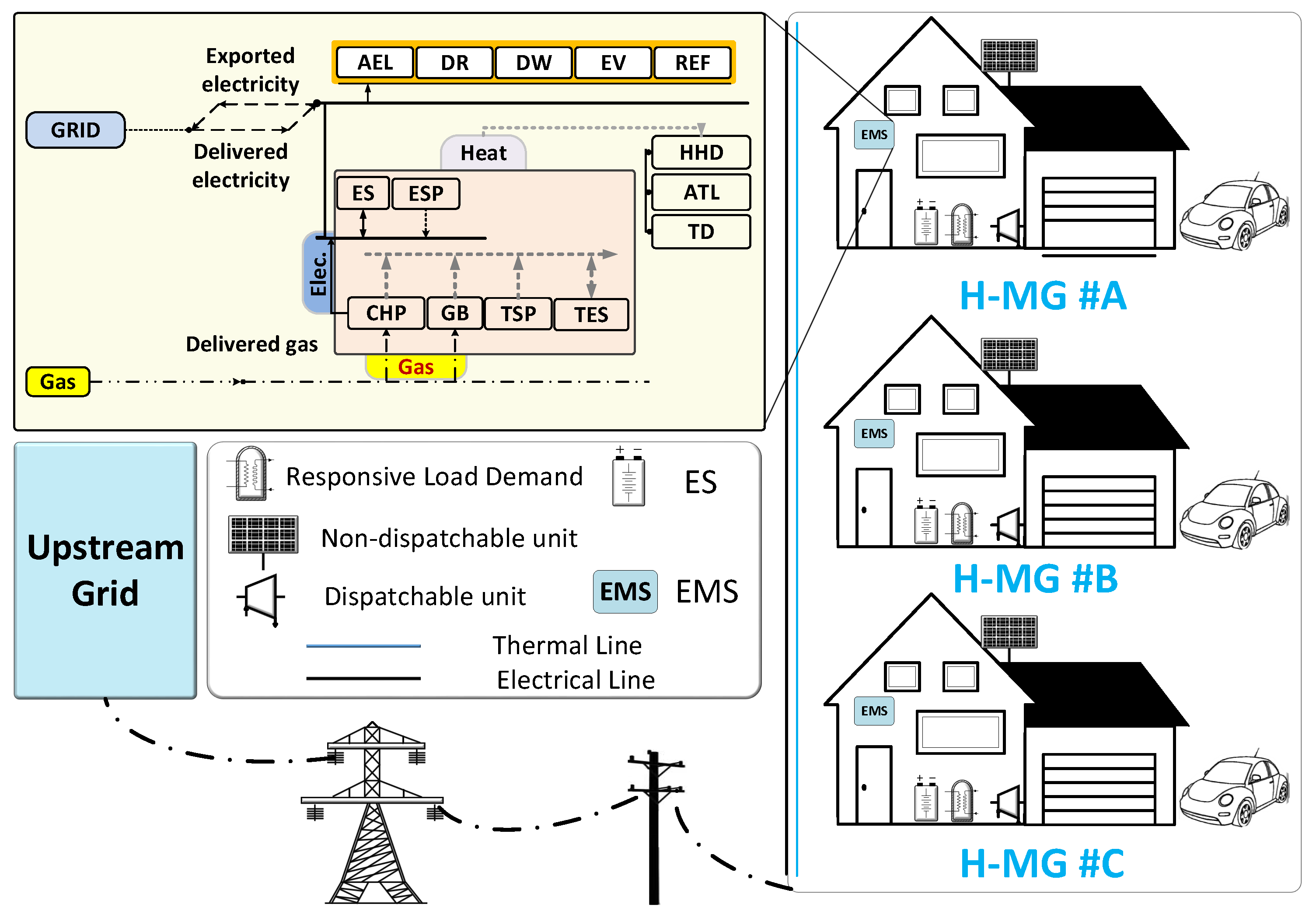



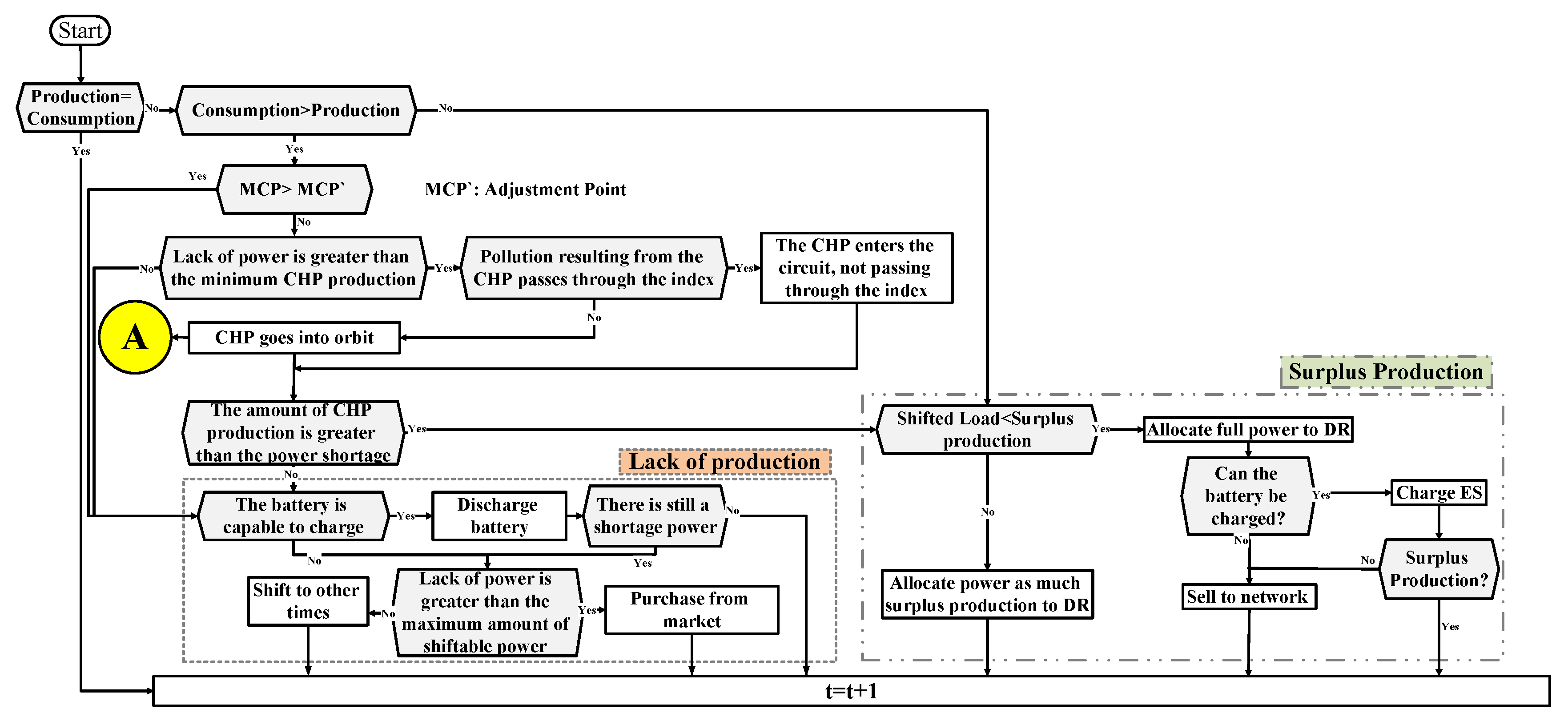
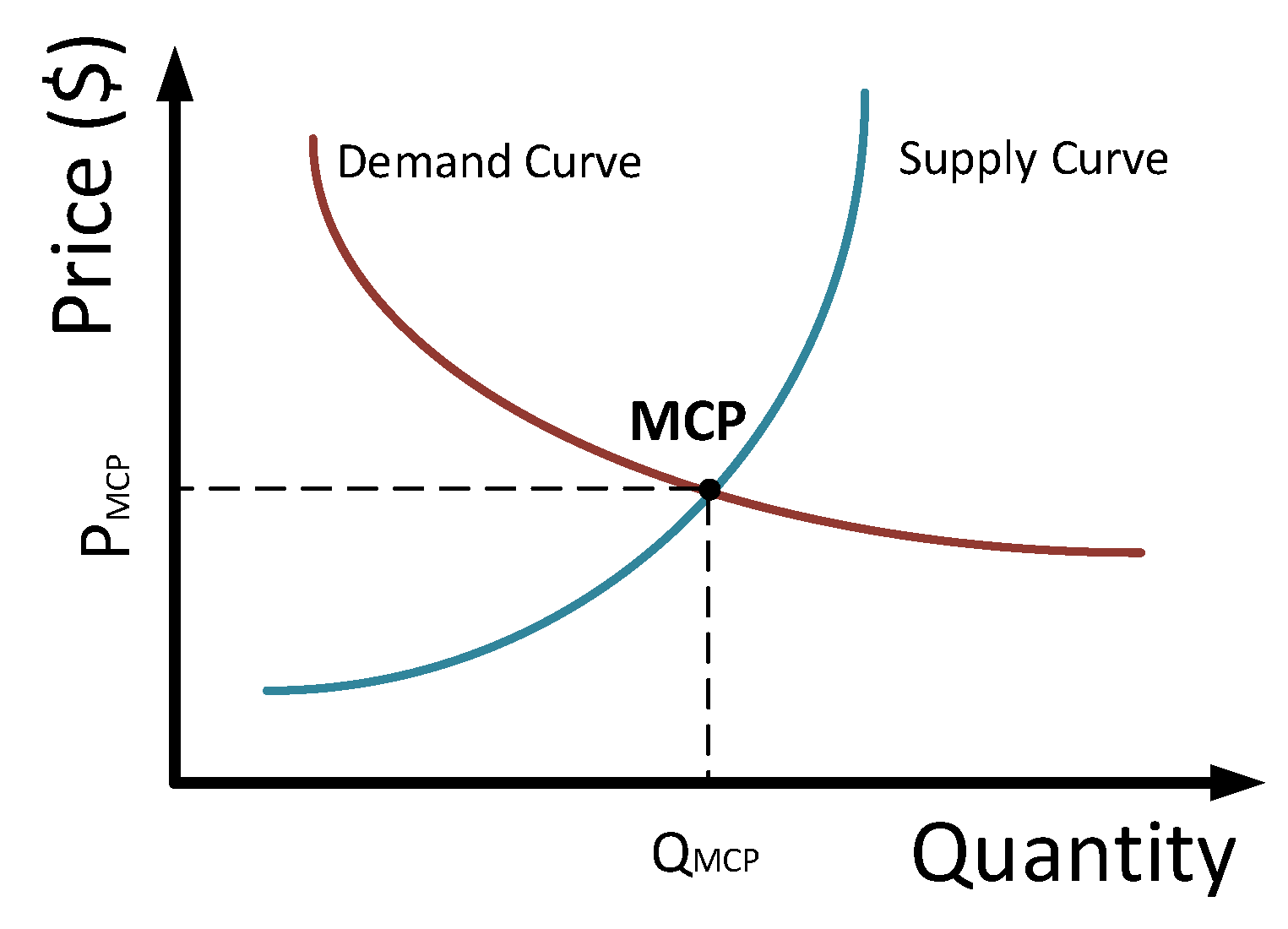
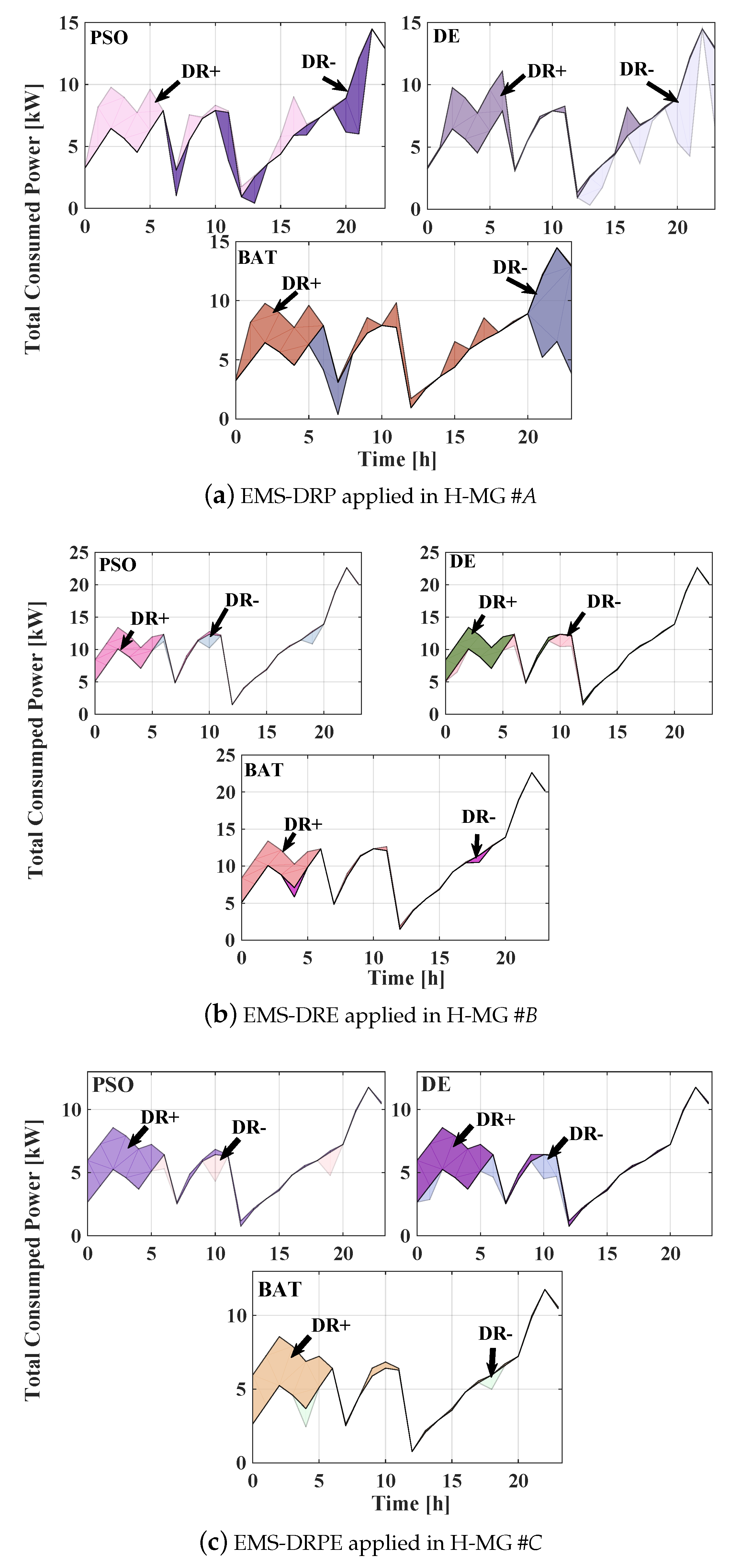

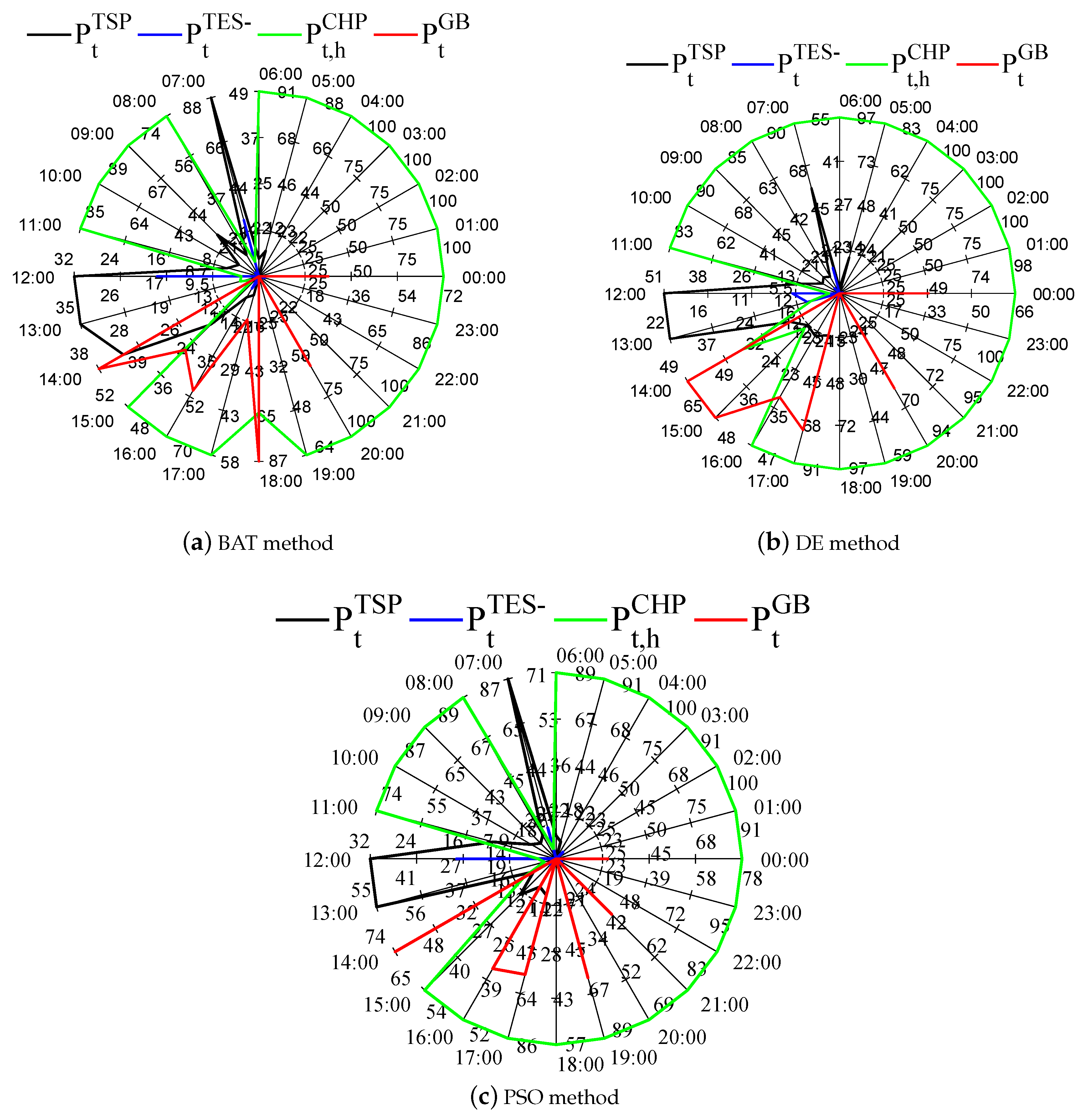
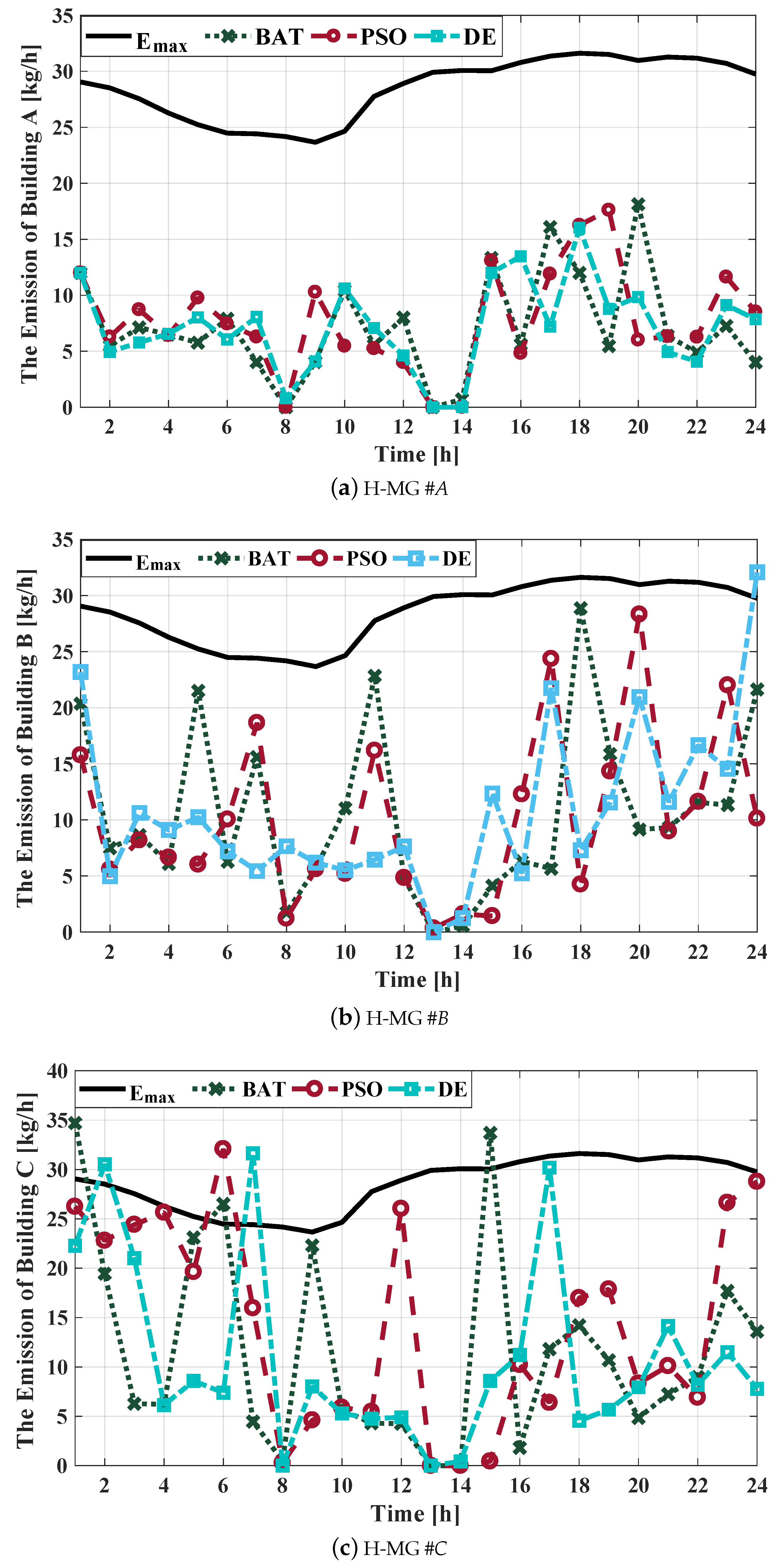
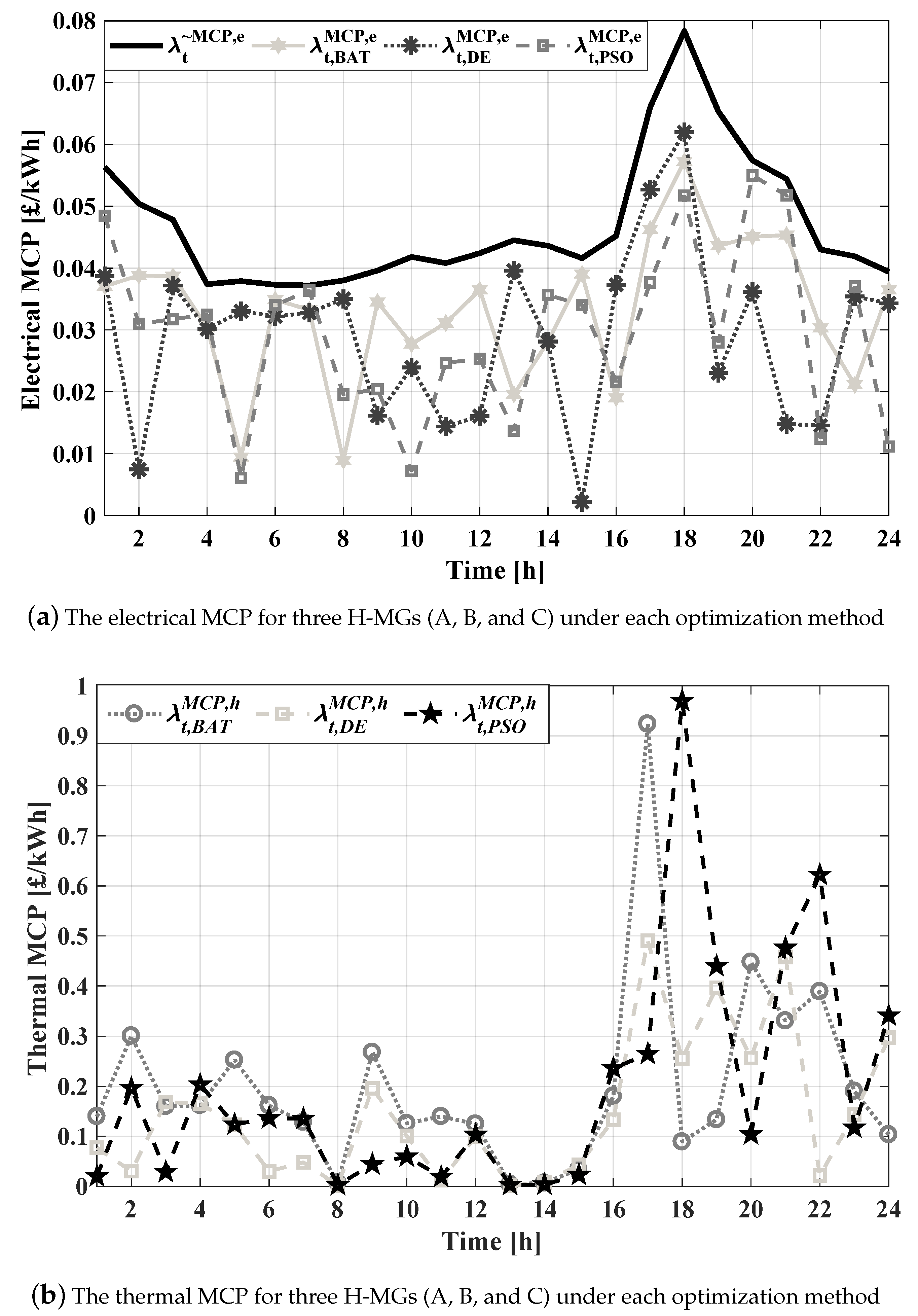
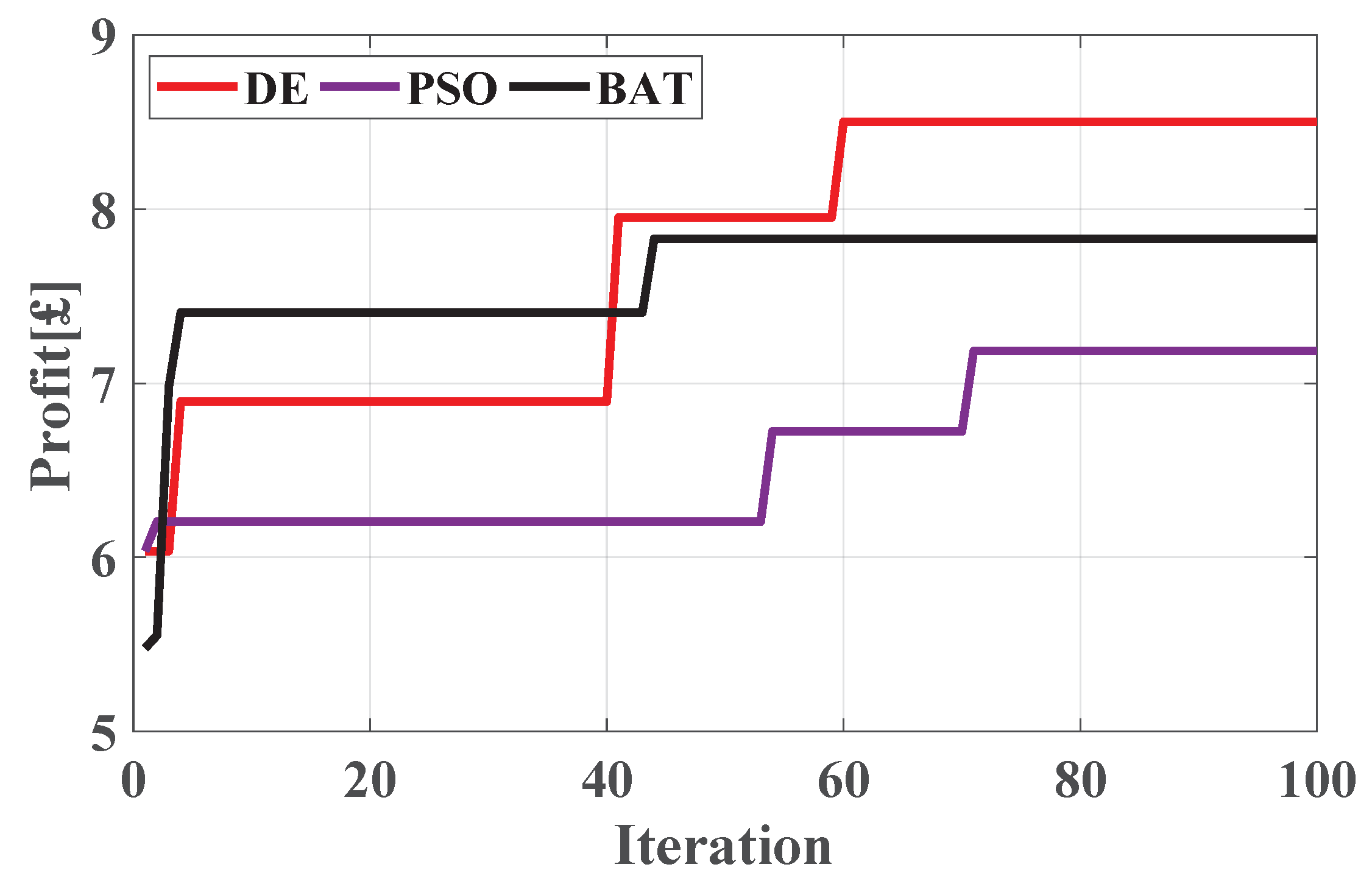
| Method | Number of Run | Minimum Profit | Maximum Profit | Averege Profit | Standard Deviation |
|---|---|---|---|---|---|
| DE | 100 | 6.03 | 8.50 | 7.85 | 0.77 |
| BAT | 100 | 5.40 | 7.80 | 7.71 | 0.33 |
| PSO | 100 | 6.03 | 7.18 | 6.54 | 0.43 |
© 2019 by the authors. Licensee MDPI, Basel, Switzerland. This article is an open access article distributed under the terms and conditions of the Creative Commons Attribution (CC BY) license (http://creativecommons.org/licenses/by/4.0/).
Share and Cite
Fouladfar, M.H.; Loni, A.; Bagheri Tookanlou, M.; Marzband, M.; Godina, R.; Al-Sumaiti, A.; Pouresmaeil, E. The Impact of Demand Response Programs on Reducing the Emissions and Cost of A Neighborhood Home Microgrid. Appl. Sci. 2019, 9, 2097. https://doi.org/10.3390/app9102097
Fouladfar MH, Loni A, Bagheri Tookanlou M, Marzband M, Godina R, Al-Sumaiti A, Pouresmaeil E. The Impact of Demand Response Programs on Reducing the Emissions and Cost of A Neighborhood Home Microgrid. Applied Sciences. 2019; 9(10):2097. https://doi.org/10.3390/app9102097
Chicago/Turabian StyleFouladfar, Mohammad Hossein, Abdolah Loni, Mahsa Bagheri Tookanlou, Mousa Marzband, Radu Godina, Ameena Al-Sumaiti, and Edris Pouresmaeil. 2019. "The Impact of Demand Response Programs on Reducing the Emissions and Cost of A Neighborhood Home Microgrid" Applied Sciences 9, no. 10: 2097. https://doi.org/10.3390/app9102097
APA StyleFouladfar, M. H., Loni, A., Bagheri Tookanlou, M., Marzband, M., Godina, R., Al-Sumaiti, A., & Pouresmaeil, E. (2019). The Impact of Demand Response Programs on Reducing the Emissions and Cost of A Neighborhood Home Microgrid. Applied Sciences, 9(10), 2097. https://doi.org/10.3390/app9102097







